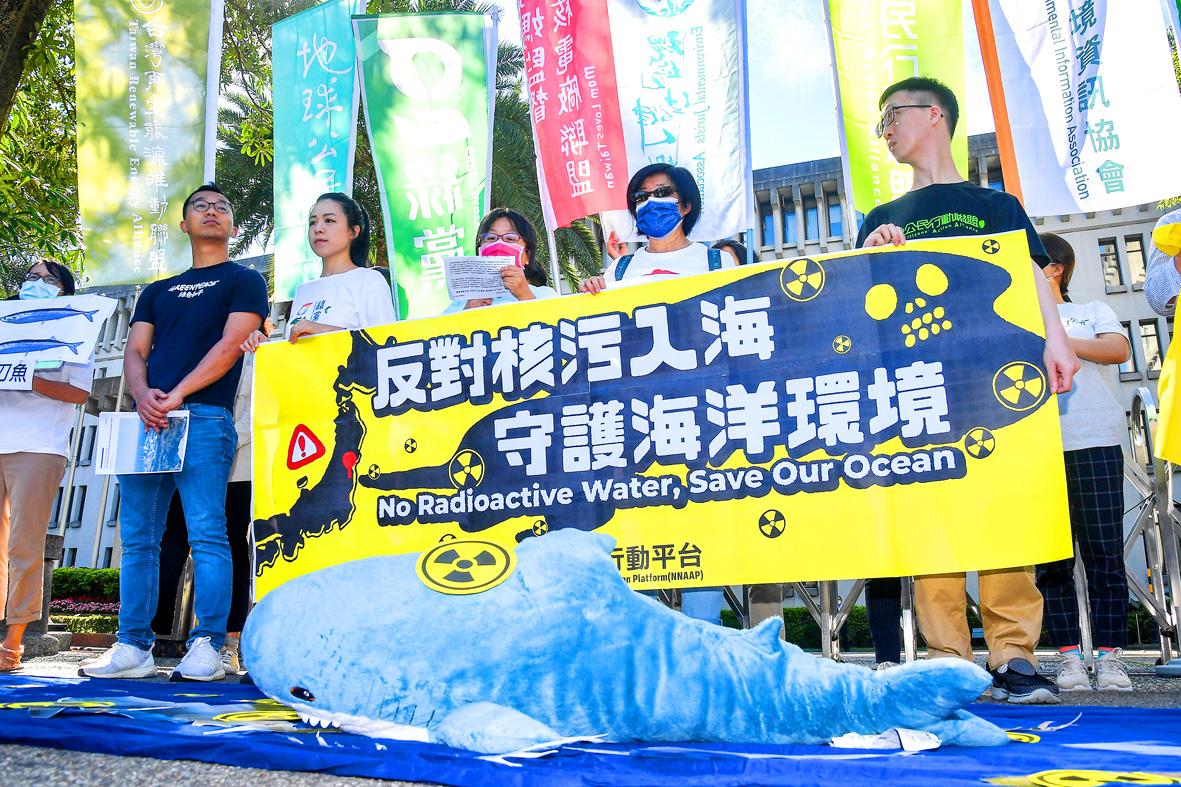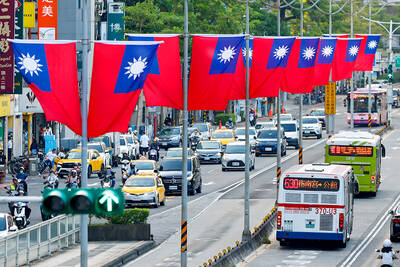The National Nuclear Abolition Action Platform yesterday called on Japan to refrain from dumping contaminated wastewater from the Fukushima Dai-ichi nuclear power plant into the ocean, warning it that it might cause up to 40 years of environmental consequences.
The group held a protest in front of the Ministry of Foreign Affairs in Taipei, prompting the ministry to promise to relay a message to Japan through the nation’s representative office in Tokyo.
The groups first placed a large sheet featuring cutouts of marine creatures on the ground and later added radioactive warning symbols to the sheet, representing the impact of the water from the wrecked plant on the ecosystem.

Photo: CNA
After Tokyo in May began soliciting ideas on how to dispose of the contaminated water, civil organizations in Taiwan jointly sent a letter to the Japanese Ministry of Economy, Trade and Industry urging it not dump it into the ocean, Green Citizens’ Action Alliance secretary-general Tsuei Su-hsin (崔愫欣) said.
However, Japanese media last month reported that Tokyo is planning on releasing the plant’s “treated” wastewater into the ocean, Tsuei said.
Tsai Ya-ying (蔡雅瀅), an attorney with the Wild at Heart Legal Defense Association, said that many migrating fish species that are important to the ecosystem travel along the Kuroshio Current that runs along the east coasts of Taiwan and Japan.
The water would contaminate their habitat, affecting the fishing industry and health of consumers, and racking up costs related to radiation detection, Tsai said, citing data from the Atomic Energy Council.
Japan should continue treating the wastewater on land, she added.
Tsai also called nuclear power operators selfish for not hesitating to pollute the oceans to save relatively little money, adding that the government is biased in their favor.
The supposedly cheap cost of nuclear power is an illusion, as the health and safety costs are passed onto others, she added.
As nuclear particles are carried by currents around the globe, the contamination might affect marine ecosystems intermittently for 30 or 40 years, Citizen of the Earth, Taiwan deputy executive director Tsai Chung-yueh (蔡中岳) said.
Ever since the plant was affected by an earthquake and a tsunami in 2011, Tokyo Electric Power has been continuously filling tanks with water used to cool damaged reactor cores, he said.
“The Fukushima nuclear disaster has not yet been solved,” but keeps on polluting, Tsai Chung-yueh said.
Taiwan-Japan Relations Association Deputy Secretary-General Hsieh Bor-huei (謝柏輝) received the complaint, saying that the ministry takes the matter very seriously.
Since the issue involves matters of environmental protection, and public health and safety, the ministry has many times expressed its concern to the Japanese government, he said.
Not only Taiwan and the international community, but also the Japanese public do not agree with the plan, Hsieh added.
Tokyo is still carefully considering its options before making a final decision, Hsieh said, adding that the ministry would relay the group’s message and urge the government to abide by the principle of transparency while evaluating its options.

Taiwanese scientists have engineered plants that can capture about 50 percent more carbon dioxide and produce more than twice as many seeds as unmodified plants, a breakthrough they hope could one day help mitigate global warming and grow more food staples such as rice. If applied to major food crops, the new system could cut carbon emissions and raise yields “without additional equipment or labor costs,” Academia Sinica researcher and lead author the study Lu Kuan-jen (呂冠箴) said. Academia Sinica president James Liao (廖俊智) said that as humans emit 9.6 billion tonnes of carbon dioxide compared with the 220 billion tonnes absorbed

The Taipei Mass Rapid Transit (MRT) Wanda-Zhonghe Line is 81.7 percent complete, with public opening targeted for the end of 2027, New Taipei City Mayor Hou You-yi (侯友宜) said today. Surrounding roads are to be open to the public by the end of next year, Hou said during an inspection of construction progress. The 9.5km line, featuring nine underground stations and one depot, is expected to connect Chiang Kai-shek Memorial Hall Station to Chukuang Station in New Taipei City’s Jhonghe District (中和). All 18 tunnels for the line are complete, while the main structures of the stations and depot are mostly finished, he

Taipei is to implement widespread road closures around Taipei 101 on Friday to make way for large crowds during the Double Ten National Day celebration, the Taipei Department of Transportation said. A four-minute fireworks display is to be launched from the skyscraper, along with a performance by 500 drones flying in formation above the nearby Nanshan A21 site, starting at 10pm. Vehicle restrictions would occur in phases, they said. From 5pm to 9pm, inner lanes of Songshou Road between Taipei City Hall and Taipei 101 are to be closed, with only the outer lanes remaining open. Between 9pm and 9:40pm, the section is

China’s plan to deploy a new hypersonic ballistic missile at a Chinese People’s Liberation Army Rocket Force (PLARF) base near Taiwan likely targets US airbases and ships in the western Pacific, but it would also present new threats to Taiwan, defense experts said. The New York Times — citing a US Department of Defense report from last year on China’s military power — on Monday reported in an article titled “The missiles threatening Taiwan” that China has stockpiled 3,500 missiles, 1.5 times more than four years earlier. Although it is unclear how many of those missiles were targeting Taiwan, the newspaper reported